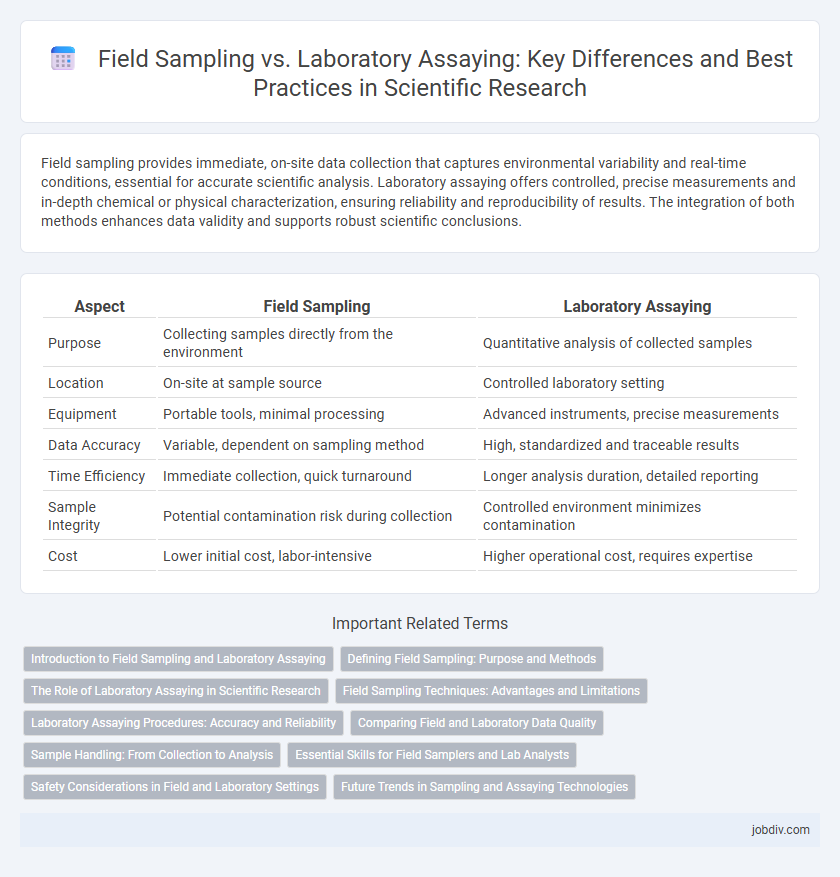Field sampling provides immediate, on-site data collection that captures environmental variability and real-time conditions, essential for accurate scientific analysis. Laboratory assaying offers controlled, precise measurements and in-depth chemical or physical characterization, ensuring reliability and reproducibility of results. The integration of both methods enhances data validity and supports robust scientific conclusions.
Table of Comparison
| Aspect | Field Sampling | Laboratory Assaying |
|---|---|---|
| Purpose | Collecting samples directly from the environment | Quantitative analysis of collected samples |
| Location | On-site at sample source | Controlled laboratory setting |
| Equipment | Portable tools, minimal processing | Advanced instruments, precise measurements |
| Data Accuracy | Variable, dependent on sampling method | High, standardized and traceable results |
| Time Efficiency | Immediate collection, quick turnaround | Longer analysis duration, detailed reporting |
| Sample Integrity | Potential contamination risk during collection | Controlled environment minimizes contamination |
| Cost | Lower initial cost, labor-intensive | Higher operational cost, requires expertise |
Introduction to Field Sampling and Laboratory Assaying
Field sampling involves the systematic collection of environmental or material samples directly from the source, ensuring representativeness and minimizing contamination. Laboratory assaying refers to the precise analytical testing of these samples to quantify chemical composition, physical properties, or the presence of specific compounds. Accurate field sampling combined with rigorous laboratory assays is essential for reliable data in scientific research and quality control.
Defining Field Sampling: Purpose and Methods
Field sampling involves collecting representative samples from the natural environment to obtain accurate data for scientific analysis. Purpose-driven methods ensure the selection of appropriate sample types, locations, and quantities to capture the variability of the study area. Common techniques include grab sampling, composite sampling, and stratified random sampling, each tailored to specific research objectives and environmental conditions.
The Role of Laboratory Assaying in Scientific Research
Laboratory assaying provides precise quantitative data essential for validating field sampling results and ensuring the accuracy of scientific research. Advanced analytical techniques such as mass spectrometry, chromatography, and spectroscopy enable detailed molecular and elemental characterization that field sampling alone cannot achieve. Accurate laboratory assays support hypothesis testing, data reproducibility, and the development of innovative scientific methodologies across various disciplines.
Field Sampling Techniques: Advantages and Limitations
Field sampling techniques offer immediate data collection from natural environments, enabling real-time analysis and reducing the risk of sample degradation during transport. These methods are cost-effective and enhance the representativeness of environmental conditions, particularly in geochemical and soil studies. However, limitations include potential contamination, limited control over variables, and challenges in maintaining sample integrity compared to controlled laboratory conditions.
Laboratory Assaying Procedures: Accuracy and Reliability
Laboratory assaying procedures prioritize precision through controlled environments, advanced instrumentation, and standardized protocols that minimize variability and enhance data reliability. Techniques such as atomic absorption spectroscopy (AAS), inductively coupled plasma mass spectrometry (ICP-MS), and X-ray fluorescence (XRF) provide quantitative elemental analysis with high sensitivity and repeatability. Calibration with certified reference materials and rigorous quality control measures further ensure accuracy, making laboratory assays indispensable for validating field sampling results.
Comparing Field and Laboratory Data Quality
Field sampling offers real-time data collection under natural environmental conditions, but may suffer from variability due to inconsistent sample handling and environmental factors. Laboratory assaying provides controlled conditions that enhance precision and reproducibility, resulting in higher data accuracy and reliability. Comparing field and laboratory data quality reveals that laboratory assays consistently deliver superior analytical sensitivity and lower detection limits, although field data remains essential for preliminary assessment and immediate decision-making.
Sample Handling: From Collection to Analysis
Sample handling from collection to analysis critically influences the accuracy of scientific results, with field sampling emphasizing immediate preservation and stabilization to prevent contamination and degradation. Laboratory assaying relies on strict protocols for sample transport, storage, and preparation, including temperature control and chain-of-custody documentation, to maintain sample integrity and enable precise analytical measurements. Optimizing these processes minimizes analytical variability and ensures reliable data for environmental monitoring, biological studies, and chemical assessments.
Essential Skills for Field Samplers and Lab Analysts
Field samplers must master precise sample collection techniques, accurate labeling, and contamination prevention to ensure data integrity before laboratory processing. Lab analysts require expertise in analytical methods, calibration of instruments, and data interpretation to produce reliable assay results. Both roles depend on rigorous adherence to standard operating procedures and quality control measures to validate findings within scientific research.
Safety Considerations in Field and Laboratory Settings
Field sampling requires stringent safety protocols such as personal protective equipment (PPE), hazard awareness, and proper handling of potentially toxic or reactive materials to prevent accidents and exposure. Laboratory assaying demands controlled environments with specialized ventilation, chemical-resistant surfaces, and adherence to standardized procedures to minimize risks related to chemical spills, contamination, and equipment hazards. Both settings must enforce rigorous safety training and emergency response plans to safeguard personnel and maintain data integrity.
Future Trends in Sampling and Assaying Technologies
Emerging trends in field sampling emphasize real-time data acquisition through portable, sensor-based technologies that enhance accuracy and reduce sample degradation. Parallel advancements in laboratory assaying involve automation and artificial intelligence integration, accelerating data analysis and improving detection limits for trace elements. These innovations collectively drive greater efficiency and precision in environmental and geological investigations.
Field Sampling vs Laboratory Assaying Infographic

 jobdiv.com
jobdiv.com